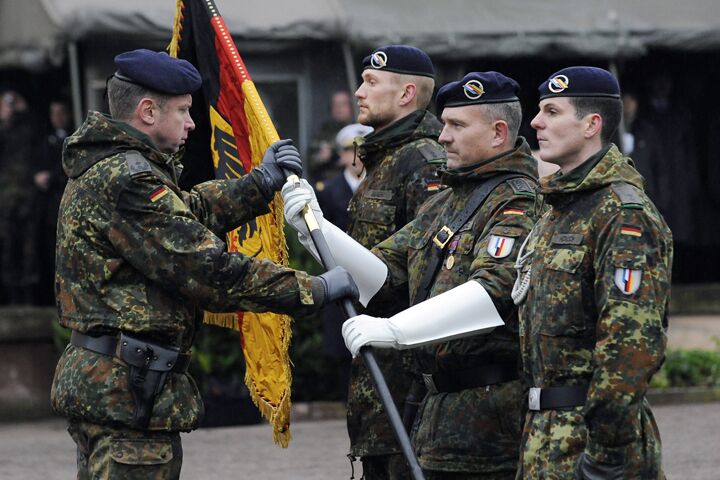
Germany on the Border
Alsace-Lorraine, France—Here in the village of Illkirch-Graffenstaden the demographic changed a week ago. Those of more senior vintage from the region of Alsace-Lorraine would no doubt be remembering a previous time when German field gray was seen right on the French border. In fact, the last time that happened, German troops plowed right on through the border, not stopping till they reached Paris.
Yet this time all is peaceful—for the moment—as a battalion of the German Bundeswehr deploys in this French-German border community. In the opinion-shaper’s public pronouncements, this falls under the grand illusion of the “democratic” union of Europe promoting friendship among former enemy nations, without any thought to changing the basic tendencies of their individual national character. It simply flies in the face of historic reality. Here in the second-largest suburb of the city of Strasbourg, about 500 personnel of the Bundeswehr are now stationed on French soil in the barracks of Illkirch-Graffenstaden.
This is one of the fastest growing cities in France, maybe even of Europe, its population more than doubling over the last four decades. The community is really a nexus of two villages, one French (Illkirch), the other German (Graffenstaden), which over time merged into the one city. Running north to south through the city and parallel to the Rhine is the River Ill. Just north of Strasbourg the Ill converges with the Rhine, close to the Rhone-Rhine Canal. Thus the waterways have been utilized for commercial convenience by the bordering French and Germans over quite a period of time.
It’s not only the waterways near Strasbourg that converge here. It’s two very different cultures, the one northern French and the other Alsatian German. That convergence has often led to conflict, with this border city having changed hands between France and Germany from time to time via acts of aggression.
The history of Illkirch-Gtraffenstaden is embedded in Frankish/Roman tradition. In fact it was Rudolph von Habsburg, king of the Romans, who in 1273 established a military tradition in Illkirch by recruiting a number of leading Strasbourg aristocrats to his cause against the rival Bohemian King Ottokar ii, elevating them to the knighthood for their services. In 1681, Strasbourg, then in German hands, was threatened by invasion from France. Failing to obtain support from the Holy Roman emperor of the time, Leopold i of the House of Habsburg, Strasbourg’s mayor sued for peace, in the process surrendering Illkirch to the French. By 1790, for economic reasons, Illkirch and Graffenstaden were merged, producing a cross-cultural Franco-German border community which in time became a virtual suburb of Strasbourg.
With a strong Romish-Frankish tradition, perhaps it is apt that the direction to station a detachment of German troops on French soil at Illkirch-Graffenstaden came from that young Bavarian Frank, Baron Karl-Theodor zu Guttenberg, who hails from the same German state as today’s vicar of Rome, Joseph Ratzinger, aka Pope Benedict xvi. It’s interesting to also note that the town contains a college bearing the name Ecole de Gutenberg, named after the founder of movable type print, who lived in Strasbourg, Johannes Gutenberg.
Following the Franco-Prussian War, Alsace-Lorraine was annexed in 1871 by Germany till its reversion to French control following German defeat in World War i. It was annexed again by Nazi Germany in 1940, only to be returned again to France in 1945. Now today’s Germany has a beginning foothold yet once again in Alsace-Lorraine by virtue of its new military presence in France’s northeastern border country. Any centenarian Frenchman surely would be forgiven for having a rather unpleasant sense of déjà vu at the sight of German field gray military uniforms parading at the French barracks at Illkirch-Graffenstaden. But centenarian Frenchmen are few and far between. The generation that remembers living under German rule twice in Alsace-Lorraine has largely died out and with it taken the memory of the aggression by which that region was taken by France’s neighbor to its north.
And that’s the problem.
Now with a current generation having failed to keep up with the history of the region of Alsace-Lorraine, the dangers of allowing a historically aggressive enemy nation to come and park “peacefully” on its doorstep are simply either ignored or not even contemplated out of ignorance to historic reality. The foreign policy of modern united Germany in the Balkan Peninsula is no different to that which German elites are pushing in regard to the establishment of a German military base in France. The methods may be different, but the imperialist intent is just the same. Whereas the Balkans has been virtually colonized by the German-dominated European Union via the Balkan wars of the 1990s, France is being colonized by Berlin/Brussels/Rome by friendship deals such as the one Guttenberg has made manifest in Illkirch-Graffenstaden.
Our booklet He Was Right will give you a remarkable perspective on the history of just what is behind the Illkirch-Graffenstaden phenomenon, where it is leading and what the outcome will be. Read it, study it and be prepared for what will follow.
Tomorrow we shall take a closer look at the Palace of Europe in Strasbourg and its symbolic meaning for the coming 10 regions of the rising United States of Europe.
